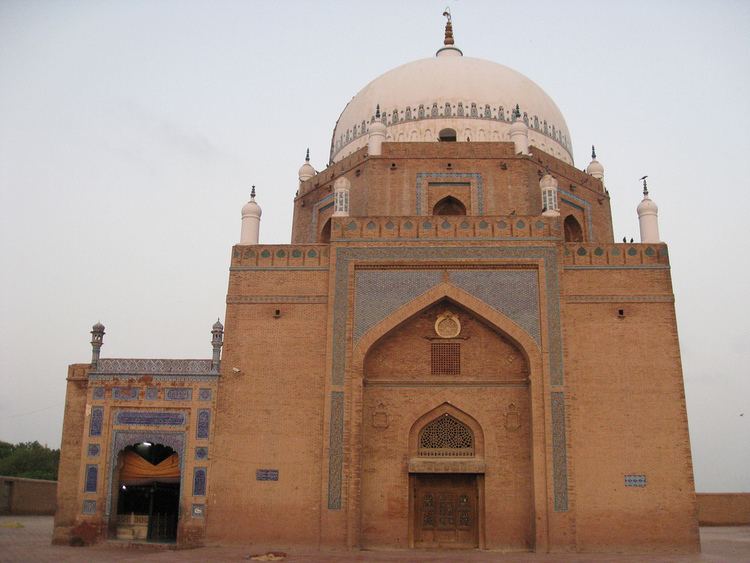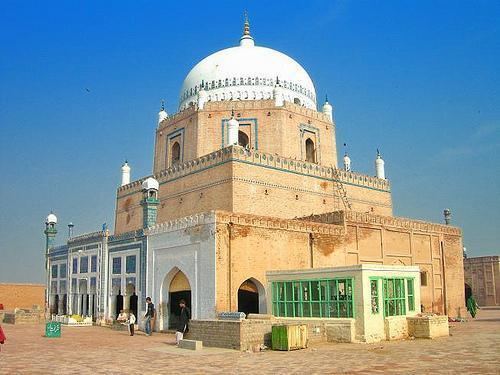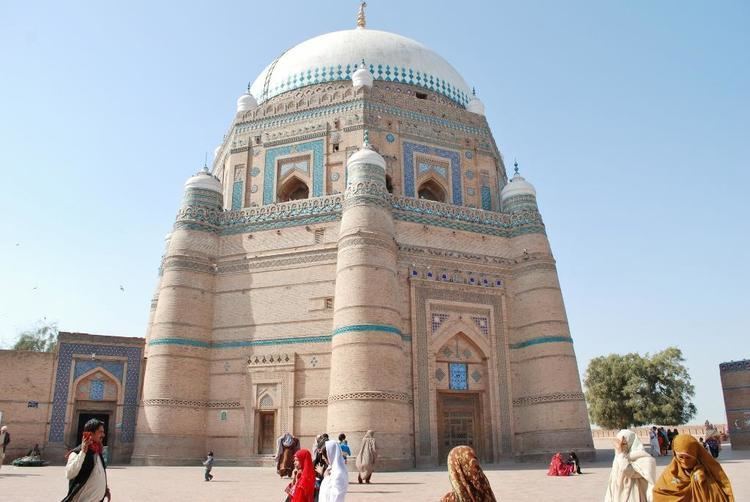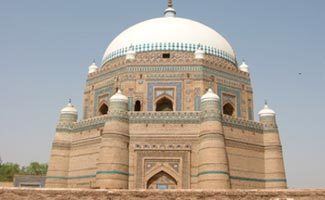Name Baha-ud-din Zakariya | ||
 | ||
Title Hadrat, Sheikh (Ghous-ul-Aalamin) Successor Various, including lal Shahbaz Qalander, Fakhr ud din Iraqi, Jalal ad-Din Muhammad Rumi and Sayyid Jalaluddin Surkh-Posh Bukhari Predecessor Shahab al-Din Yahya ibn Habash Suhrawardi Similar People Rumi, Bayazid Bastami, Muhammad bin Tughluq, Shams Tabrizi, Attar of Nishapur | ||
Period in office 12th/13th century | ||
Ziarat e dargah hazrat bahauddin zakariya r a multan pakistan
Baha-ud-din Zakariya (Urdu and Persian: بہاؤ الدین زکریا) (1170-1267), also spelled as Bahauddin Zakariya, and also known as Baha-ul-Haq and Hazrat Bahauddin Zakariya Multani (Rahmatullah Alaih), was a Sufi of Suhrawardiyya order (tariqa). His full name was Abu Muhammad Bahauddin Zakariya. He was from the lineage of Hadhrat Asad Ibn Hashim hence Hashmi.
Contents
- Ziarat e dargah hazrat bahauddin zakariya r a multan pakistan
- Writings
- Family Tree
- Descendants
- Memorandum
- Sufi order
- Followers Slogans
- References

Sheikh Baha-ud-Din Zakariya was born at Kot Kehror (Karor Lal Esan), a town of the Layyah District near Multan, Punjab, Pakistan, around 1170. His grandfather Shah Kamaluddin Ali Shah Qureshi arrived in Multan from Mecca en route to Khwarezm where he stayed for a short while.

In Tariqat, he was the disciple of renowned Sufi master Shaikh Shahab al-Din Suhrawardi who awarded him Khilafat only after 17 days of stay at his Khanqah in Baghdad. For fifteen years, he travelled to different cities in order to preach Islam and finally settled in Multan in 1222.

Writings

( اوراد شيخ الشيوخ : الاوراد : اوراد سهروردي)
Baha-ud-Din Zakariya died in 1268 and his mausoleum (Darbar) is located in Multan. The mausoleum is a square of 51 ft 9 in (15.77 m), measured internally. Above this is an octagon, about half the height of the square, which is surmounted by a hemispherical dome. The mausoleum was almost completely ruined during the Siege of Multan in 1848 by the British, but was soon afterward restored by Muslims. Many pilgrims visit his shrine at the time of his urs from different parts of Pakistan and beyond.
Family Tree
Hazrat Baha-ud-Din Zakariya Abu Muhammad Al-Asadi Al-Hashmi Al-Qureshi SON OF
Wajih-ud-Din Ali Shah Qureshi SON OF
Kamal-ud-Din Aba Bakar Al-Qureshi SON OF
Sultan Jalal-ud-Din Al Qureshi SON OF
Shaykh Ali Qazi Al-Qureshi SON OF
Shaykh-ud-Din Shaheed SON OF
Sultan Hussain Matrif Al-Qureshi SON OF
Sultan Hazeema Al-Qureshi SON OF
Sultan Abd-Allah Al-Qureshi SON OF
Sultan Hazim Al-Qureshi SON OF
Ameer Taj-ud-Din Matrif Al-Qureshi SON OF
Abd-ur-Rehman bin Habbar SON OF
Habbar bin Asad (His brother was Hunain bin Asad bin Hashim and his sister was the Mother of Hazrat Ali) SON OF
Asad bin Hashim (ancestor of Asadites/Asadi) SON OF
Hashim (ancestor of Hashmites/Hashmi) SON OF
Abd Munaaf SON OF
Qusaii SON OF
Kilaab SON OF
Murrah SON OF
Ka'ab SON OF
Luvai SON OF
Ghalib SON OF
Fahar (Forefather and Ancestor of Quraysh Tribe).
Descendants
Now-a-days, Baha-ud-Din Zakariya has thousands of descendants in the subcontinent and abroad from his Seven sons.
Baha-ud-din Zakariya had seven sons who gained fame in their own right as great Sufis - Shaykh Sadruddin Arif, Shaykh Burhanuddin, Shaykh Ziauddin, Shaykh Alauddin, Shaykh Qudrat-ud-din, Shaykh Shahab-ud-din, and Shaykh Shams-ud-din. Shaykh Sadruddin Arif's son was the famous Sufi Shaykh Abul Fath Ruknuddin, also known as Shah Rukn-e-Alam. His progeny dispersed all over Indian subcontinent during the coming centuries and produced many famous people in all walks of life and scholarship. Today his descendants are found in Multan, Karor Lal Esan, Islamabad, Rawalpindi, Qureshi Morh (Dera Ismail Khan), Shaykh Yusuf (Dera Ismail Khan), Main City (Dera Ismail Khan), Near Gomal University (Dera Ismail Khan), Paniala (Dera Ismail Khan), Gujrat, Gujar Khan, Watli (Chakwal), Pir Khara (Chakwal), Karoli Piran (Chakwal), Dharabi (Chakwal), Pail Piran (Khushab), Tibba Qaim Din (Khushab), Bhera (Sargodha), Purmiana (Attock), Lahore, and Hazara. In Hazara, Sufi saint Hazrat Mian Mohammad Niaz, the forefather of Hazrat Qazi Mir Aalam Qureshi, is buried in Basian Berote Kalan Hazrat Qazi Mir Aalam had for sons. His second son Hazrat Badar Munir Qureshi(Qalander e Zaman) followed his spiritual order. He was a disciple of Peer Bahar Ali Qalander who lived in the mountains of Noshehra near Darbar of Hazrat Kaka Sahib in Khilwat for 40 years. Hazrat Bader Munir Qureshi is buried in Islamabad.His descendants have spread around, namely Siddiq Ahmed Qureshi, Aftab Ahmed Qureshi, Zafar Iqbal Qureshi, Shafiq Ahmed Qureshi and Khalid Munir Qureshi. The descendants of Hazrat Mian Mohammad Niaz are also found in India in the cities of Delhi, Meerut, and Allahabad. Some in Kashmir in the old city of srinagar (Lal bazar) reside . One of His descendant Hazrat Ahmad Qari visted and resided there during Akhbars reign at the behest of Sufi saint of Kashmir Hazrat Makhdoom Hamza. reignSince the independence of Pakistan in 1947 many of his descendants from India have migrated to Khushab, Bhakkar, Layyah, Mianwali. Some of his descendants use Hashmi while some use Qureshi with their name. Some of his descendants use as Qureshi Hashmi. Makhdoom Pir Javed shah Hashmi is the current Sajjada Nashin of Darbar Hazrat Baha-ud-din Zakariya
Memorandum
Sufi order
Baha-ud-Din Zakariya belonged to the Suhrawardiyya Sufi order, which was well known in the Mamluk Sultanate of India. He was one of the disciples of Sheikh ul-Sheiyukh Shahabuddin Suhrawardy. Multan had come to be known as "Baghdad of the East" after he settled here. It is mentioned in the following couplet of Bahaul Haq in Persian :
Multan ma ba jannat a'la barabar ast Ahista pa ba-nah ke malik sajda mi kunad. (Multan of ours is comparable to the great Paradise, Tread slowly, the angels are paying obeisance here.)Followers' Slogans
حضرت پير بهاوالحق رح
سخي پير حضرت پير بهاوالحق رح
مدد ڪر مرشدغوٽ بهاوالحق رح
زنده آهي غوٽ رح زنده آهي غوث رح
